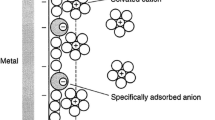Abstract
The methods of electrode kinetics, particularly steady state current-potential and impedance-potential measurements, have been successfully applied to the investigation of gas forming reactions, such as chlorine, oxygen and hydrogen evolution. Developments in computer-controlled instrumentation have made these the preferred methods (together with potential pulse methods). The paper discusses the results and suggests how these can be interpreted in terms of the electron transfer reaction and the bubble layer.
Similar content being viewed by others
Abbreviations
- c bA :
-
bulk concentration of A
- C sA :
-
surface concentration of A
- C dl :
-
differential capacity
- D a :
-
diffusion coefficient of A
- E :
-
potential w.r.t SCE electrode
- E 0 :
-
standard potential w.r.t SCE (1 mol cm−3 concentrations)
- k A :
-
rate constant w.r.t appliedE
- F :
-
Faraday number
- i :
-
current density
- j :
-
square root of −1
- a :
-
anodic Tafel slope
- b :
-
cathodic Tafel slope
- R ω :
-
ohmic loss resistance
- R ct :
-
charge transfer resistance
- Z(ω):
-
impedance
- ω :
-
frequency of ac potential
- δ :
-
diffusion layer thickness
- σ :
-
Warburg impedance parameter
References
S. Trassatti, Advances in Electrochemistry and Electrochemical Engineering Vol. 10 (edited by H. Gerischer and C. W. Tobias), John Wiley, New York (1977) p. 294.
J. A. Harrison,Electrochim. Acta 27 (1982) 1113.
J. A. Harrison, D. L. Caldwell and R. E. White,ibid. 29 (1984) 1139.
L. J. J. Janssen and E. Barendrecht,ibid. 29 (1984) 1207.
J. A. Harrisonibid. 29 (1984) 703.
J. A. Harrison, D. L. Caldwell and R. E. White,ibid. 28 (1983) 1561.
K. J. Vetter, ‘Electrochemical Kinetics’, Academic Press, New York (1967).
J. A. Harrison, D. E. Caldwell and R. E. White,Electrochim. Acta 29 (1984) 203.
J. A. Harrison, in ‘Modern Chlor-Alkali Technoogy’ Vol. 2 (edited by C. Jackson), Ellis-Horwood, Chichester (1983) p. 246.
J. A. Harrison and A. T. Kuhn,Surface Technol. 19 (1983) 249.
Idem, J. Electroanal. Chem. (in press).
I. L. Cooper and J. A. Harrison,Electrochem. Acta 29 (1984) 1147.
Idem, ibid. 29 (1984) 1165.
B. E. Conway, L. Bai and D. F. Tessier,J. Electroanal. Chem. 161 (1984) 39.
D. A. Denton, J. A. Harrison and R. I. Knowles,Electrochim. Acta 26 (1981) 1197.
Author information
Authors and Affiliations
Rights and permissions
About this article
Cite this article
Harrison, J.A. The application of the methods of electrode kinetics, especially the impedance, to the study of gas evolving reactions at electrodes. J Appl Electrochem 15, 495–501 (1985). https://doi.org/10.1007/BF01059290
Received:
Issue Date:
DOI: https://doi.org/10.1007/BF01059290




